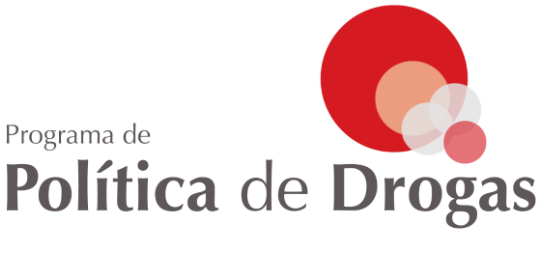Investigaciones: Publicaciones
The Connection Between Drug-Related Detentions and Drug-Related Violence: Another Failure of the War on Drugs in Mexico
- Laura H. Atuesta
- Publicado: 2024

This paper analyses the relationship between drug-related detentions for possession or petty dealing and drug-related violence. Two theoretical mechanisms are explored: (i) when a dealer is detained, the market is disrupted, and competition increases; (ii) when a consumer is detained, other consumers are deterred and seek new dealers, generating competition among groups and, consequently, increasing violence. These hypotheses are quantitatively evaluated using geocoded data from local San Luis...
Where there is smoke, there is fire? Making sense of the past failure and future prospects of cannabis reform in Chile
- Jonas von Hoffmann
- Publicado: 2023

A decade ago, cannabis reform was on the public and political agenda in Chile, but the reform process eventually broke down with no marijuana legalization. This article focuses on the different stages of agenda politics to explain the reasons for the failure of cannabis reform in Chile. Drawing on original data, including 36 interviews with key actors, the article traces the reform process. Through a combination of process tracing and counterfactual analysis, the article establishes the causal...
Civil Society Organizations and Harm Reduction Policy: The Mexican Case
- Edgar Guerra & Guus Zwitser
- Publicado: 2023

The present study offers an outlook on the current situation of civil society organizations (CSOs) in the field of harm reduction in Mexico. Analyzing Mexican harm reduction civil society organizations (HRCSOs) is necessary for three reasons: because they have historically represented a sensible alternative to drug policy proposals that emanate from the logic of the State; because they have the organizational and cognitive potential and the legitimacy to protect illicit substance users (with or...
“Resulta aberrante su actuar”: Mujeres acusadas de delincuencia organizada
- Sara Elena Velázquez Moreno & Javier Treviño Rangel
- Publicado: 2023

Resumen Entre 2017 y 2021 se duplicó la cantidad de mujeres acusadas de delincuencia organizada en México y, actualmente, este es el delito más común entre mujeres privadas de la libertad en centros de reclusión federales. Sin embargo, los análisis académicos acerca de mujeres acusadas por este delito son todavía marginales. Y los pocos estudios existentes sobre este tipo penal tienden a ignorar el género de la persona acusada....
How frequent and visible criminal violence affects housing prices: evidence from Mexico City (2007–2011)
- Laura H. Atuesta & Monserrat Carrasco
- Publicado: 2023

Purpose. Between 2006 and 2012, Mexico implemented a “frontal war against organized crime”. This strategy increased criminal violence and triggered negative consequences across the country’s economic, political and social spheres. This study aims to analyse how the magnitude and visibility of criminal violence impact the housingmarket ofMexico City. Design/methodology/approach – The authors used different violent proxies to measure the effect of the magnitude and...
The Unintended Consequences of Conditional Cash Transfer Programs for Violence: Experimental and Survey Evidence from Mexico and the Americas
- Daniel Zizumbo Colunga
- Publicado: 2023

Because conditional cash transfer programs (CCTs) can address the deep roots of violence, many scholars and policymakers have assumed them to be an effective and innocuous tool to take on the issue. I argue that while CCTs may have positive economic effects, they can also trigger social discord, criminal predation, and political conflict and, in doing so, increase violence. To test this claim, I take advantage of the exogenous shock caused by the randomized expansion of Mexico’s flagship...
La metanfetamina y el CJNG. Análisis de una reconfiguración del mercado de sustancias ilegales en el occidente mexicano
- Nancy Estrella Chávez Llamas, Isaac Vargas, Sara Elena Velázquez Moreno, Alejandra García De Loera
- Publicado: 2022
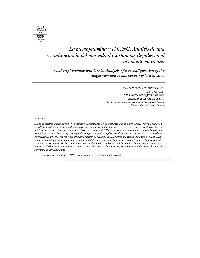
Desde el discurso gubernamental y la literatura especializada, se ha postulado que el Cártel Jalisco Nueva Generación (CJNG) es una de las redes criminales más poderosas en México, tanto en términos territoriales como en económicos. Con el objetivo de conocer cómo opera en el territorio la economía del Cártel y sus alcances regionales, desarrollamos una metodología mixta. Ésta incluye trabajo de campo...
Muertes invisibles: Del subregistro oficial al registro comunitario de muertes por sobredosis en México (1998-2020)
- Ospina-Escobar, A, Ramos Rodríguez, M. E., Zambrano, María Gisela & Rojas Padilla, Julián
- Publicado: 2022
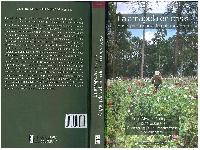
El aumento de las muertes por sobredosis asociadas al uso de opiáceos, que desde el inicio del milenio se registra en los Estados Unidos, no ha tenido un eco importante en este lado de la frontera. En México, el discurso mediático alrededor de los opiáceos se ha centrado en posicionar la letalidad del fentanilo y en mostrar desde 2016 el aumento de los decomisos por parte de las autoridades. En respuesta a este vacío de información, este texto...
Lilith y Eva. Estereotipos hacia mujeres usuarias de sustancias en proveedores de servicios de tratamiento residencial.
- Angélica María Ospina-Escobar
- Publicado: 2022
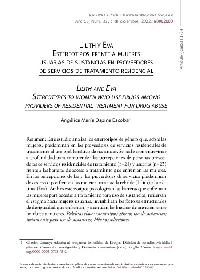
Este estudio analiza los estereotipos de género que, sobre las mujeres, predominan en los proveedores de servicios residenciales de tratamiento al uso problemático de sustancias. Se realizaron entrevistas a profundidad para comprender las percepciones de personas proveedoras de servicios residenciales de tratamiento (n=28) y usuarias (n=23)frente a las barreras de acceso a tratamiento que enfrentan las mujeres. En las percepciones de las y los proveedores de servicios...
Culpa, empatía e identificación. Reflexiones sobre la experiencia emocional en el trabajo de campo con varones que se inyectan drogas
- Angélica María Ospina-Escobar
- Publicado: 2022

El objetivo de este texto es presentar un análisis reflexivo de las emociones de culpa, identificación y empatía, y su aporte a la construcción de vínculos sociales durante un trabajo de campo que realicé con varones que se inyectan drogas en Hermosillo, Sonora. Para ello, describo cómo construí mi relación con Paco, un hombre que se inyectaba heroína y que vinculé al proceso de investigación en calidad de...
Visitar las cárceles durante la pandemia por COVID-19: el encarcelamiento como factor de desigualdad
- Pérez Correa González, Catalina; Calzada Olvera, Rebeca & Coutiño, José Enrique
- Publicado: 2022
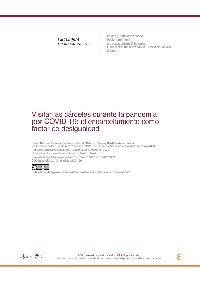
Este estudio cualitativo presenta los resultados de una encuesta no representativa realizada a personas con un familiar privado de la libertad en México. El objetivo fue entender cómo las principales medidas adoptadas por las autoridades para mitigar contagios dentro de los reclusorios afectaron a familiares que cuidan de las personas encarceladas. La encuesta recibió 234 respuestas que fueron procesadas en el software R (R, 2022). Si bien los resultados no son...
How to Start over: Coping Mechanisms during Individual Women Displacement by Organized Crime
- Maria del Pilar Fuerte-Celis, Daniel Zizumbo-Colunga
- Publicado: 2022

Every year, thousands of innocent victims—often women—leave their communities individually and in silence to escape the direct and indirect violence that criminal organizations exert. We explore and catalog the coping strategies these victims implement during what we call individual displacement. Then, we analyze in-depth interviews with women in Mexico—a country going through a severe insecurity crisis—to illustrate how individual, familial, social, and institutional...
Confinement with No Rights. Perceptions of Inmates’ Relatives Regarding Measures for COVID-19 Control Implemented in Mexican Prisons
- Angélica Ospina-Escobar
- Publicado: 2022
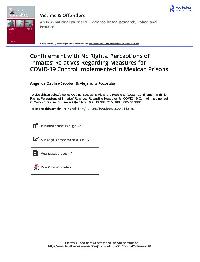
Based on a participatory study design, this article describes how a group of family members of people deprived of liberty (PDL) experienced the COVID-19 control measures implemented in Mexico’s prisons. We conducted 28 in-depth interviews and analyzed them using ATLAS.ti. We found that the measures implemented in Mexican prisons to avoid the spread of COVID-19 focused mainly on suspension of visitation and PDL confinement. The isolation imposed on PDL impacted their living conditions,...
Transition from first illegal drug use to first injection among people who inject drugs in Northern Mexico: A retrospective survival analysis
- Angélica Ospina-Escobar, Carlos Magis-Rodríguez
- Publicado: 2022
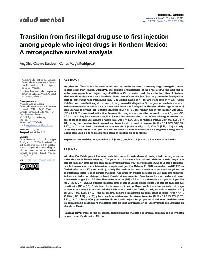
Existe poca información en México sobre los calendarios al uso inyectado de drogas en ciudades distintas a Tijuana. Comparamos las características del inicio del consumo de drogas y la primera inyección entre las personas que se inyectan drogas (PID) de Hermosillo y Ciudad Juárez e identificamos factores asociados con la transición a la primera inyección. Método: En 2012 encuestamos a 841 PID en Ciudad Juárez ( n = 445) y Hermosillo...
Prohibitionist Drug Policy in Mexico: A Systemic Constitutional Underminer
- Francisca Pou Giménez y Catalina Pérez Correa González
- Publicado: 2022
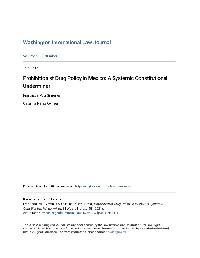
Este artículo en el Washington International Law Journal explora y desarrolla un amplio conjunto de argumentos que demuestran la inconstitucionalidad de las políticas de prohibición de drogas en México. Algunos de estos argumentos se han utilizado para validar los usos recreativos y terapéuticos de la marihuana, mientras que otros siguen sin utilizarse ni explorarse. Existen más de diez marcos constitucionales que sirven para evaluar la...
Organized crime-related disappearances in Mexico: evidence from Durango, Tamaulipas, and Coahuila
- Laura Atuesta e Isaac Vargas González
- Publicado: 2022

More than 77,000 people have disappeared in Mexico since the beginning of the war on drugs, but very little is known about them. After analyzing the descriptions of a non-randomized sample of disappearance registries from governmental data, we find that those events associated with organized crime are better understood by analyzing four factors: migration to the U.S. border and traveling on highways, gender differences and individual vs. multiple-victim disappearances, the forced recruitment of...
Impact of an overdose reversal program in the context of a safe consumption site in Northern Mexico
- David Goodman-Meza, Said Slim, Lourdes Angulo, Pablo Gonzalez-Nieto, Mary C. Cambou, Alejandra Loera, Steve Shoptaw & Jaime Arredondo
- Publicado: 2022
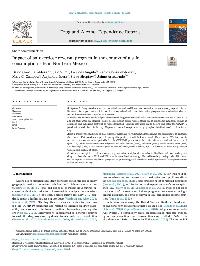
Abstract Drug overdoses are prevalent in low- and middle-income countries but are scarcely reported in the literature. We report on an opioid overdose reversal and naloxone distribution program that was instituted at the first safe consumption site in Latin America.
Familias y diversidad
- Andrea K. Sánchez Zepeda, Edgar I. Zazueta Luzanilla, Luz M. Galindo Vilchis, Tania L. Meléndez Elizalde
- Publicado: 2021
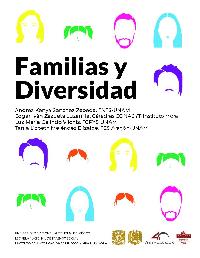
El documento busca situar la falta de acceso a servicios públicos de atención al uso problemático de drogas y los retos que ello supone para las familias que tienen a alguno de sus miembros atravesando por esta condición. Para ello recurro al concepto de privatización de cuidado, a través del cual se plantea cómo el uso problemático de drogas es construido conceptual y políticamente como una...
División sexual del trabajo y confinamiento en jóvenes de preparatoria. Un estudio de caso de Aguascalientes, México
- Nancy Estrella Chávez Llamas & Angélica María Ospina-Escobar
- Publicado: 2021
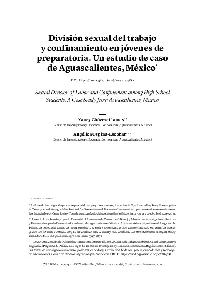
Abstract This qualitative case study describes how a group of young students from a public high school in Aguascalientes (Mexico) experienced the confinement for the COVID-19 pandemic. Our main finding is the intensification of the sexual division of labor. While women intensified their domestic and care work participation, men were pushed to enter the informal labor market to support their household economy. Men dropped out of school to a greater extent than women, which could mean that...
¿Del aula a la pantalla? Experiencia escolar durante COVID-19 en un bachillerato mexicano
- Nancy Estrella Chávez Llamas & Angélica María Ospina-Escobar
- Publicado: 2021
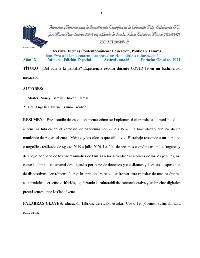
Abstract This case study documents how the transition to the hybrid teaching modality was implemented in the context of a COVID-19 pandemic in a public high school in a municipality of Aguascalientes, Mexico and the effects that this had. The work responds to an ethnographic exercise carried out from August 2019 to July 2020. The lack of economic resources in the homes and of support from the parents to the school activities of the young people, as well as the limited capacities teachers...
Flying Under the Radar: How Frames Influence Public Officials’ Perceptions of Corruption
- Daniel Zizumbo Colunga & Oliver Meza
- Publicado: 2021
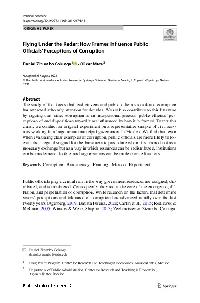
Abstract The study of the forces that lead citizens and public officials to tolerate corruption has attracted scholarly attention for decades. We seek to contribute to this literature by arguing that -since corruption is an interpersonal process- public officials’ perceptions of and dispositions toward it are influenced by how it is framed. To test this claim, we conduct an original experiment on a representative sample of civil servants working in a large urban municipal government...
Deadly force and denial: the military's legacy in Mexico's ‘war on drugs’
- Javier Trevino-Rangel, Raúl Bejarano-Romero, Laura H. Atuesta & Sara Velázquez-Moreno.
- Publicado: 2021
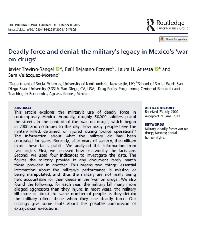
Abstract This article explores the military's use of deadly force in contemporary Mexico. Annually, roughly 50,000 soldiers patrol the streets in the context of the ‘war on drugs', which began in 2006 and continues to this day. How many people have the military killed, detained, or injured during ‘police operations'? The information about what the military do has been concealed for years. Recently, after years of secrecy, the military made these facts public. We...
Age-specific rates of onset of cannabis use in Mexico
- Mauricio López-Méndez, Angélica Ospina-Escobar, Rowan Iskandar & FernandoAlarid-Escudero.
- Publicado: 2021
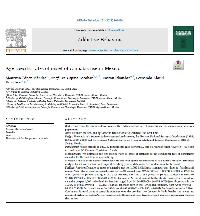
Abstract Background: Over the previous two decades, the lifetime prevalence of cannabis use has risen among Mexico’s population. Aims: Estimate the sex- and age-specific rates of onset of cannabis use over time. Design: Five nationally representative cross-sectional surveys, the Mexican National Surveys of Addictions (1998, 2002, 2008, 2012) and the Mexican National Survey on Drugs, Alcohol, and Tobacco Consumption (2016). Setting: Mexico. Measurements: We estimated the...
El sistema de atención y cuidado al uso problemático de drogas en México: aislamiento, estigmatización y desamparo
- Angélica Ospina-Escobar
- Publicado: 2021
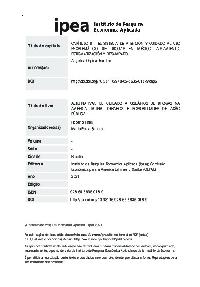
En este capítulo se analiza la manera cómo se estructuran actualmente los arreglos institucionales para la atención al uso problemático de sustancias psicoactivas en México. El documento busca responder a cuatro preguntas centrales: ¿Cuáles son las características del sistema de atención al uso problemático de sustancias en México?, ¿Cómo se conformó históricamente dicho sistema?,...
Constraints and military coordination: How ICTs shape the intensity of rebel violence
- Martín Macías-Medellín & Laura H. Atuesta
- Publicado: 2021
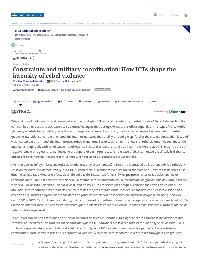
Summary Why and how do information and communication technologies (ICTs) shape the intensity of rebel violence? Recent studies find that ICTs can both increase and decrease such violence. We argue that, during civil wars, this effect depends on the type of ICTs. Mobile phones give rebels better military coordination to organize violence. In contrast, the internet increases the constraints of rebel groups to use violence. On the one hand, the internet increases the visibility of rebel groups...
Geographical and socioeconomic disparities in opioid access in Mexico, 2015–19: a retrospective analysis of surveillance data
- Goodman-Meza, et.al.
- Publicado: 2021
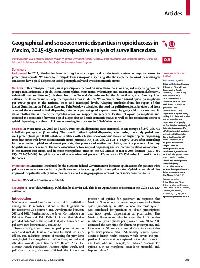
Summary Background In 2015, Mexico implemented regulatory changes and an electronic system to improve access to prescription opioids. We aimed to investigate trends in opioid dispensing after the implementation of these changes and assess how opioid dispensing varied geographically and by socioeconomic status. Methods In this retrospective analysis of prescription medication surveillance data, we analysed dispensing data for group 1 medications (all opioids, including...
A Populist President Tests El Salvador’s Democracy
- Sonja Wolf
- Publicado: 2021
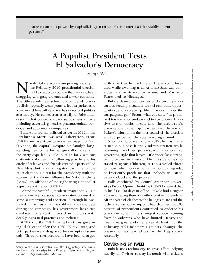
Abstract In June 2019, Nayib Bukele, a former mayor affiliated with the former guerrilla movement FMLN, became president of El Salvador at the head of a new party allied with a splinter faction of the right-wing ARENA party. Capitalizing on the corruption scandals that tainted the two major parties, the youthful businessman rode to victory on an anti-sleaze platform. He has made Twitter his government’s main communications platform, using symbolic politics to achieve high public...
They Must Have Done Something! Socioeconomic Status and Citizens’ Support for the Victims of Violence
- Daniel Zizumbo-Colunga
- Publicado: 2020

Abstract Why do some victims of criminal atrocities mobilize the public while others do not? I argue that victims’ socioeconomic background systematically biases citizens’ evaluations. I use experimental methods to assess this claim among a representative sample of citizens and elites interviewed during the Mexican war on drugs. I find citizens to be more likely to dismiss victims as responsible for their misfortune when they come from lower socioeconomic strata, and that this...
“Pick up anything that moves”: a qualitative analysis of a police crackdown againstpeople who use drugs in Tijuana, Mexico
- Morales M, Rafful C, Baker P, Arredondo J, Kang S, Mittal ML, Rocha-Jiménez T, Strathdee SA, Beletsky L.
- Publicado: 2020
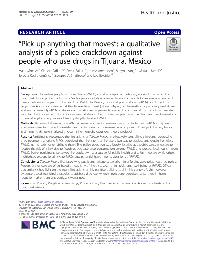
Abstract Background: Homeless people who use drugs (PWUD) are often displaced, detained, and/or forced into drug treatment during police crackdowns. Such operations follow a zero-tolerance approach to law enforcement and have a deleterious impact on the health of PWUD. In Mexico, municipal police officers (MPOs) conducted the largest crackdown documented at the Tijuana River Canal (Tijuana Mejora) to dismantle an open drug market. We analyzed active-duty...
La ley en nuestras manos: Autoridades, comunidad y la rebelión de Cherán
- Daniel Zizumbo Colunga
- Publicado: 2020
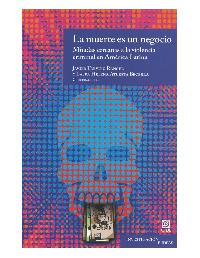
La justicia vigilante no es un fenómeno nuevo. A principios del siglo XX comunidades del oeste de Estados Unidos atacaban bandas criminales para hacer cumplir la ley, por fuera del Estado (Allen, 2004). Lo novedoso es que en América Latina dos siglos después de la independencia política y del establecimiento del Estado de derecho, la justicia vigilante haya resurgido. Si bien en la década de 1990 este fenómeno se concentraba en países como...
Sujeción: Forma y función de los rituales criminales en la operación de los Caballeros Templarios
- Edgar Guerra
- Publicado: 2020
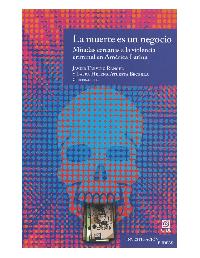
En todo caso, los distintos rituales sí generaban un sentido de pertenencia. En todos los niveles, ser templario representaba una posición de poder e influencia, sí, pero también de cierto reconocimiento social y de compromiso moral hacia el grupo criminal. Para los miembros de las organizaciones criminales las identidades permiten construir cierta distinción como miembro de un colectivo (el grupo criminal) frente a otros colectivos sociales. Además, les...
Violencia sexual y reproductiva hacia mujeres que se inyectan drogas en la frontera norte de México. ¿La frontera de los derechos?
- Angélica Ospina
- Publicado: 2020
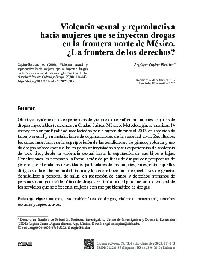
Abstract Objetivo: evidenciar las experiencias de violencia que enfrentan mujeres usuarias de drogas inyectables residentes en Ciudad Juárez, México. Metodología: se analizan 14 entrevistas en profundidad recolectadas por la autora durante el 2013 en espacios de trabajo sexual y en instalaciones de organizaciones de la sociedad civil. Resultados: los datos muestran que la superposición de las condiciones de género, pobreza y uso de drogas sobreexpone a las...
"Valer o no valer". Poder y estatus en rituales de socialización en varones que se inyectan drogas en Hermosillo, Sonora
- Angélica Ospina-Escobar
- Publicado: 2020

Durante el trabajo de campo desarrollado en el marco de mi tesis de doctorado,1 las emociones, que no eran objeto de mi estudio, emergieron de manera contundente tanto en los relatos biográficos construidos a partir de entrevistas en profundidad, como en mis interacciones con los participantes en el estudio. Por un lado, en los relatos biográficos, la frustración, el enojo, la euforia, la humillación y el orgullo, entre otras emociones, acompañaban de manera...
Addressing Police Occupational Safety During an Opioid Crisis: The Syringe Threat and Injury Correlates (STIC) Score
- Leo Beletsky, Daniela Abramovitz, Jaime Arredondo, Pieter Baker, Irina Artamonova, Phil Marotta, Maria Luisa Mittal, Teresita Rocha-Jimenez, Javier A. Cepeda, Mario Morales, Erika Clairgue, Thomas A..
- Publicado: 2020
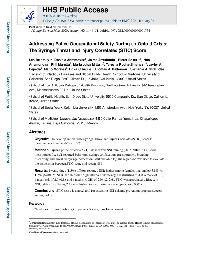
Objective: To develop and validate Syringe Threat and Injury Correlates (STIC) score to measure police vulnerability to NSI. Methods: Tijuana police officers (N=1,788) received NSI training (2015-2016). STIC score incorporates five self-reported behaviors: syringe confiscation, transportation, breaking, discarding, and arrest for syringe possession. Multivariable logistic regression was used to evaluate the association between STIC score and recent...
Fentanyl is used in Mexico's northern border: current challenges for drug health policies
- Clara Fleiz, Jaime Arredondo, Alfonso Chavez, Lilia Pacheco, Luis A. Segovia, Jorge A. Villatoro, Silvia L. Cruz, María E. Medina‐Mora, Juan R. de la Fuente
- Publicado: 2019

Abstract Background and Aims Results from a recent study among 750 heroin users in three Mexico's northern border cities revealed an increase in white powder availability (also known as China white) and preference for this product among heroin users, as well as a general perception of increased overdose cases among this population. Here, we questioned whether those findings reflect an increased presence of heroin laced with fentanyl, which is associated with greater risks of...
Drug checking services at music festivals and events in a Canadian setting
- Karen McCrae, Samuel Tobias , Kenneth Tupper , Jaime Arredondo, Bonnie Henry , Silvina Mema , Evan Wood , Lianping Ti
- Publicado: 2019
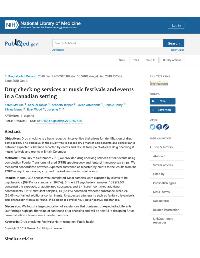
Abstract Objectives: Drug checking is a harm reduction intervention that allows for identification of drug composition. The objective of the study was to assess drug market components and concordance between expected substance reported by clients and results from point-of-care drug checking at music festivals and events in British Columbia. Methods: From July to September 2018, we provided drug checking services at four events using combination Fourier Transform Infrared (FTIR)...
Gender Matters? How Does Gender Shape Risk Environment for Syringe Sharing Among People who Inject Drugs in Northern Mexico
- Angélica Ospina-Escobar, Fátima Juárez
- Publicado: 2019
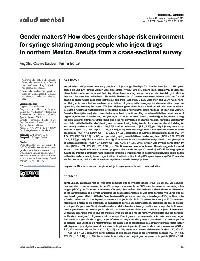
La prevalencia del VIH entre personas que se inyectan drogas (PIDs) es del 5%. Los estudios han encontrado que la prevalencia del VIH es aproximadamente del 10% entre las mujeres que se inyectan drogas (MIDs) y del 5% entre los hombres. Objetivo. Este artículo busca describir detalladamente diferencias en las características que forman ambientes de riesgo diferenciados al VIH entre hombres y mujeres que se inyectan drogas en México. Método. Se entrevistó a 824...
The “War on Drugs” in Mexico: (Official) Database of Events between December 2006 and November 2011
- Laura Atuesta, Oscar Siordia y Alejandro Madrazo
- Publicado: 2019
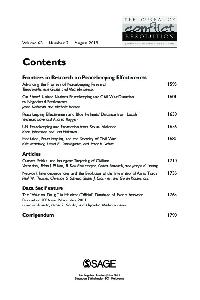
Abstract The objective of this text is to describe the three categories that the Drug Policy Program at the Center for Teaching and Research in Economics (CIDE-PPD) database comprises, their limitations, and their main features. Additionally, we explain what we believe to be the source of the database we originally received and analyze its accuracy by comparing it with public records. We describe the validation and codification processes the database was subjected to, as well as the main...
Drug Policy in Mexico: The Cause of a National Tragedy—A Radical but Indispensable Proposal to Fix It
- Ernesto Zedillo, Catalina Pérez-Correa, Alejandro Madrazo y Fernanda Alonso
- Publicado: 2019
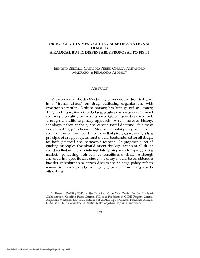
Abstract For over a decade, the Mexican government has invested itself in a “frontal attack” on drug trafficking organizations with catastrophic results. Little to nothing has been gained in limiting drug production, use, or trafficking, while violence has skyrocketed and major institutional and human rights crises have evolved. Through a multidisciplinary approach—which includes history, sociology, policy analysis, and constitutional doctrine—this essay evaluates...
Cambios en las dinámicas de compraventa y uso de drogas. Un análisis generacional para Hermosillo, Sonora
- Angélica Ospina
- Publicado: 2019

Abstract El artículo examina cambios generacionales en las formas de vinculación entre delincuencia organizada y varones con uso problemático de drogas en Hermosillo, Sonora. Para ello, se reconstruyen narrativas biográficas que relacionan el tiempo individual de los varones participantes con el tiempo histórico de la producción y tráfico de drogas ilegales en México y el tiempo social de los cambios socioeconómicos...
Interactive Versus Video-Based Training of Police to Communicate Syringe Legality to People Who Inject Drugs: The SHIELD Study, Mexico, 2015-2016
- Arredondo, et.al.
- Publicado: 2019
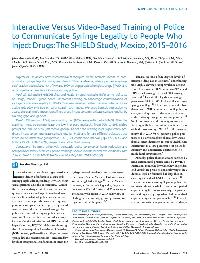
Abstract Objectives. To assess how instructional techniques affect officers' intent to communicate syringe legality during searches in Tijuana, Mexico, where pervasive syringe confiscation potentiates risk of HIV and HCV among people who inject drugs (PWID) and of occupational needle-stick injury among police. Methods. Using the SHIELD (Safety and Health Integration in the Enforcement of Laws on Drugs) model, Tijuana police underwent training to encourage communication of...
Attitudes towards safe consumption sites among police and people with lived experience in Tijuana, Mexico: initial report from the field
- Jaime Arredondo-Sánchez Lira, Clara Fleiz-Bautista, Pieter Baker, Jorge A. Villatoro-Velázquez, Mario Domínguez-García, Leo Beletsky
- Publicado: 2019
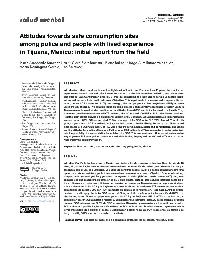
Abstract Introduction. Mexico northern border has high levels of heroin use. For more than 10 years, the country has implemented several harm reduction interventions to reduce the risks associated with drug use. New strategies such as Safe Consumption Sites (SCS) must be considered as a next step to service vulnerable populations and increase their health outcomes. Objective. This report seeks to measure and compare attitudes on a potential SCS intervention in Tijuana among...
Entre el orgullo y la vergüenza. El espectro emocional en las biografías de varones que se inyectan drogas en Hermosillo, Sonora
- Angélica María Ospina-Escobar
- Publicado: 2019
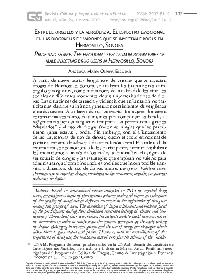
A partir de nueve relatos biográficos de varones que se inyectan drogas de Hermosillo, Sonora, se analizan las fluctuaciones entre orgullo y vergüenza, como indicadores de la calidad de los vínculos sociales en diferentes momentos de sus trayectorias de uso de drogas. Las situaciones de carencia y violencia que enfrentaron los participantes durante su infancia generaron sentimientos de vergüenza e inadecuación. A lo largo de sus biografías los sujetos...
Trusting the source: The potential role of drug dealers in reducing drug-related harms via drug checking
- Geoff Bardwell, Jade Boyd, Jaime Arredondo, Ryan McNeil, Thomas Kerr
- Publicado: 2019
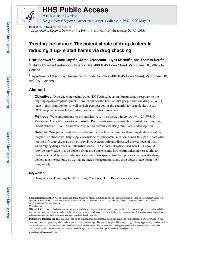
Abstract Objectives: Drug checking technologies (DCTs) have been implemented as a response to the ongoing opioid overdose epidemic. We examined the level of trust people who use drugs (PWUD) have in their drug dealers as well as their perspectives on the potential for drug dealers to use DCTs to provide knowledge of drug contents to their customers. Methods: We conducted one-to-one qualitative semi-structured interviews with 20 PWUD in Vancouver, Canada's Downtown Eastside....
Assessing police officers’ attitudes and legal knowledge on behaviors that impact HIV transmission among people who inject drugs
- Cepeda, J. et.al.
- Publicado: 2018

Abstract Background Policing practices such as syringe confiscation and arrest can act as important social-structural drivers of HIV risk among people who inject drugs (PWID). However, police referral to treatment and other services may improve the health of PWID. Little is known about the role of modifiable attitudinal and knowledge factors in shaping officer behavior. Using baseline findings from a police education program (PEP), we assessed relationships between drug policy...
Brief Report: Improving Police Conceptual Knowledge of Mexico’s Law on Cannabis Possession
- Mittal, M. et.al.
- Publicado: 2018

Abstract Background and objectives Policing practices do not reflect recent decriminalization of drug possession in Mexico. We assessed knowledge of cannabis law as part of a police education program (PEP) post-drug law reform in Tijuana. Methods Officers took pre-/post-PEP surveys; random subsample (n = 759) received follow-up assessments. Longitudinal logistic regression (pre-, post-, 3-months post-PEP) measured knowledge of cannabis law. Results PEP...
Mourning our dead: The impact of Mexico’s war on drugs on citizens’ depressive symptoms
- Iván Flores Martínez y Laura Atuesta
- Publicado: 2018
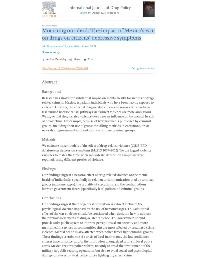
Abstract Background Research has shown the substantial impact on mental health for victims of drug-related crime in Mexico, especially individuals who have been heavily exposed to violence. However, the effect of drug-related violence in non-victims has been less studied because causal pathways via indirect violence are more ambiguous. We argue that drug-related violence does have an influence on the mental health of non-victims: For example, because of how violence is publicized...
Factors associated with extrajudicial arrestfor syringe possession: results of adepartment-wide survey of municipalpolice in Tijuana, Mexico
- Morales, et.al.
- Publicado: 2018
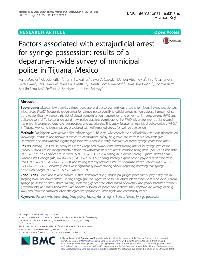
Abstract Background: Mexican law permits syringe purchase and possession without prescription. Nonetheless, people whoinject drugs (PWID) frequently report arrest for syringe possession. Extrajudicial arrests not only violate human rights,but also significantly increase the risk of blood-borne infection transmission and other health harms among PWID andpolice personnel. To better understand how police practices contribute to the PWID risk environment, prior researchhas primarily examined...
The global health and equity imperative for safe consumption facilities
- Beletsky, L. et.al.
- Publicado: 2018
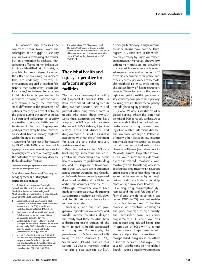
The first safe consumption facility (SCF) opened its doors in 1986, in Bern, Switzerland, intending to curb drug overdose-related deaths and prevent other drug-related harm in people who inject drugs (PWID). Since then, communities who have adopted the SCF approach have seen decreases in HIV incidence, injection-related litter and disorder, and drug overdose.Use of SCFs is also associated with uptake of treatment for drug use and other recovery assistance services. Mounting evidence...
The effect of public health-oriented drug law reform on HIV incidence in people who inject drugs in Tijuana, Mexico: an epidemic modelling study
- Alejandro Madrazo, et al.
- Publicado: 2018
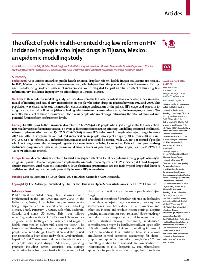
Summary Background As countries embark on public health-oriented drug law reform, health impact evaluations are needed. In 2012, Mexico mandated the narcomenudeo reform, which depenalised the possession of small amounts of drugs and instituted drug treatment instead of incarceration. We investigated the past and future effect of this drug law reform on HIV incidence in people who inject drugs in Tijuana, Mexico. Methods In this epidemic modelling study, we used data from the El...
La "guerra contra las drogas". Análisis de los combates de las fuerzas públicas 2006-2011.
- Alejandro Madrazo, Rebeca Calzada y Jorge Javier Romero
- Publicado: 2018
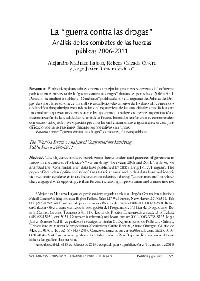
Resumen El objetivo planteado es entender mejor las prácticas concretas de las fuerzas públicas en el contexto de la “guerra contra las drogas” durante el periodo de 2006 a 2011. Para ello, se analizó la subbase “Combates” publicada por el Programa de Política de Drogas del cide. El texto ofrece un análisis estadístico-descriptivo de los datos allí contenidos e identifica dos principales tendencias en las...
Undermining Constitutionalism in the Name of Policy: The Constitutional Costs of the War on Drugs
- Alejandro Madrazo y Antonio Barreto
- Publicado: 2018
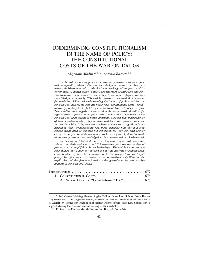
Abstract Public policies are supposed to be transitory measures meant to faceand solve public problems. Constitutional design, by contrast, involves per-manent decisions adopted to rule the inner workings of the polity and itsgovernment. Although policy is most often imagined as transitory and con-stitutional law as permanent, some policy decisions reconfigure constitu-tional design permanently. This Article proposes a new analytic frameworkfor rendering visible and understanding the...
Comparing Risk Environments for HIV Among People who Inject Drugs from Three Cties in Northern Mexico
- Angelica Ospina-Escobar, Carlos Magis-Rodríguez, Fatima Juárez, Dan Werb, Sergio Bautista Arredondo, Rubén Carreón, María Elena Ramos y Steffanie Strathdee
- Publicado: 2018
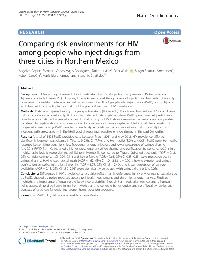
A large body of research has investigated the rise of injection drug use and HIV transmission in Tijuana and Ciudad Juarez (CJ). However, little is known about the dynamics of injecting in Hermosillo. This study compares drug-related behaviors and risk environment for HIV of people who inject drugs (PWID) across Tijuana, CJ, and Hermosillo to identify factors that could explain differences in HIV prevalence.
The law on the streets: Evaluating the impact of Mexico's drug decriminalization reform on drug possession arrests in Tijuana, Mexico
- J Arredondo, T Gaines , S Manian, C Vilalta , A Bañuelos, S A Strathdee, L Beletsky
- Publicado: 2018
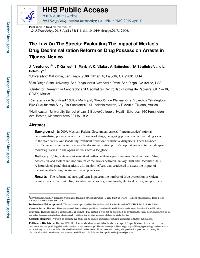
Abstract Background: In 2009, Mexican Federal Government enacted "narcomenudeo" reforms decriminalizing possession of small amounts of drugs, delegating prosecution of retail drug sales to the state courts, and mandating treatment diversion for habitual drug users. There has been insufficient effort to formally assess the decriminalization policy's population-level impact, despite mounting interest in analagous reforms across the globe. Methods: Using a dataset of...
Measuring improvement in knowledge ofdrug policy reforms following a police education program in Tijuana, Mexico
- Arredondo, et.al.
- Publicado: 2017
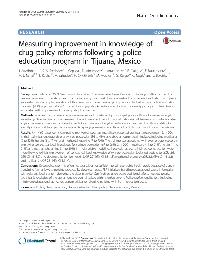
Abstract Background:Mexico’s 2009“narcomenudeo reform”decriminalized small amounts of drugs, shifting some druglaw enforcement to the states and mandating drug treatment diversion instead of incarceration. Data from Tijuanasuggested limited implementation of this harm reduction-oriented policy. We studied whether a police educationprogram (PEP) improved officers’drug and syringe policy knowledge, and aimed to identify participant characteristicsassociated with...
Meet the Narco: increased competition among criminal organisations and the explosion of violence in Mexico
- Laura Atuesta, Aldo Ponce
- Publicado: 2017
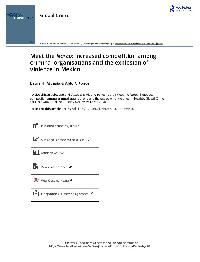
ABSTRACT Several previous studies have found that interventions by security forces against criminal organisations result in increased violence related to organised crime. However, much less is known about how and why this effect occurs. Our study not only identifies the causal mechanisms that explain this outcome, but also evaluates the empirical validity of these mechanisms. Employing a novel data set, we find that following security-force intervention, the number of criminal...
Fragmentation and cooperation: the evolution of organized crime in Mexico
- Laura Atuesta, Samantha Pérez
- Publicado: 2017
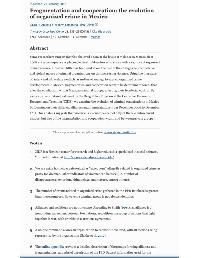
Some researchers suggest that the observed boom in the levels of violence in Mexico since 2008 are a consequence of placing federal military forces in states with a significant organized crime presence. However, little has been said about the role of the changeable, competitive, and violent nature of criminal organizations on this increasing violence. Using the literature on inter- and intra-state conflicts as matter of analogy to explain organized crime developments in Mexico, fragmentation...
The Spatial-Temporal Pattern of Policing Following a Drug Policy Reform: Triangulating Self-Reported Arrests With Official Crime Statistics
- Gaines, T. et. al.
- Publicado: 2017
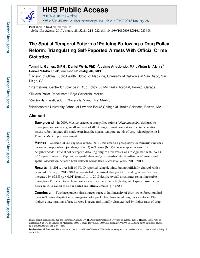
Abstract Background: In 2009, Mexico enacted a drug policy reform (Narcomenudeo) designed to divert persons possessing small amounts of illicit drugs to treatment rather than incarceration. To assess reform impact, this study examines the spatial-temporal trends of drug-related policing in Tijuana, Mexico post-enactment. Method: Location of self-reported arrests (N = 1,160) among a prospective, community-recruited cohort of people who inject drugs (PWID) in Tijuana (N = 552) was...
Prevalence and correlates of needle-stick injuries among activeduty police officers in Tijuana, Mexico
- Mittal, M. et.al.
- Publicado: 2016

Abstract Introduction:Police officers are at an elevated risk for needle-stick injuries (NSI), which pose a serious and costly occupationalhealth risk for HIV and viral hepatitis. However, research on NSIs among police officers is limited, especially in low- and middle-income countries. Despite the legality of syringe possession in Mexico, half of people who inject drugs (PWID) in Tijuana reportextrajudicial syringe-related arrests and confiscation by police, which has been associated...
Criminals and Enemies? The Drug Trafficker in Mexico's Political Imaginary
- Alejandro Madrazo
- Publicado: 2016
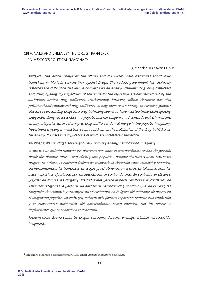
Abstract This article compares the official and the widely held discourses about drug traffickers in Mexico’s current War against Drugs. The federal government has obliquely distorted the distinction between a criminal and an enemy, dehumanizing drug traffickers and, thus, opening up a spectrum of tolerance for the repressive actions carried out by the authorities against drug traffickers. Inadvertently, however, official discourse has also politicized and empowered drug...
Narcomessages as a way to analyse the evolution of organised crime in Mexico
- Laura Atuesta
- Publicado: 2016

ABSTRACT Drug-related homicides in Mexico have increased to levels never before seen and organised crime has evolved accordingly, becoming more fragmented and diverse. This work analyses the evolution of organised crime and drug-related violence in Mexico by examining how drug trafficking organisations (DTOs) communicate through the messages left next to executed bodies from 2007 to 2011. Results suggest that the use of narcomessages has changed and developed in parallel with...
Public health and international drug policy
- Alejandro Madrazo, et al.
- Publicado: 2016

Abstract In September, 2015, the member states of the UN endorsed Sustainable Development Goals (SDGs) for 2030, which aspire to human-rights-centred approaches to ensuring the health and wellbeing of all people. The SDGs embody both the UN Charter values of rights and justice for all and the responsibility of states to rely on the best scientific evidence as they seek to better humankind. In April, 2016, these same states will consider control of illicit drugs, an area of social policy...
Los costos constitucionales de la guerra contra las drogas: dos estudios de caso sobre las transformaciones de las comunidades políticas
- Antonio Barreto y Alejandro Madrazo
- Publicado: 2015
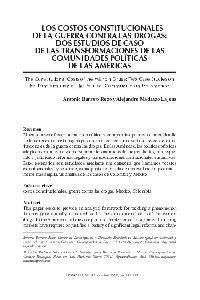
Abstract El texto busca ofrecer un marco analítico y comparativo para estudiar en detalle un fenómeno que hasta hoy ha pasado prácticamente inadvertido: los costos constitucionales de la guerra contra las drogas. En las Américas, las políticas públicas adoptadas en un esfuerzo por suprimir los mercados de drogas ilícitas, han requerido o justificado reformas legales y transformaciones institucionales sustantivas. Estos escenarios son...
Do Mexicans flee from violence? The effects of drug-related violence on migration decisions in Mexico
- Laura Atuesta y Dusan Paredes
- Publicado: 2015
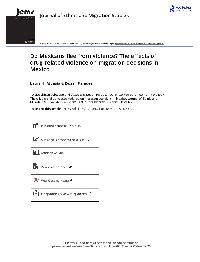
ABSTRACT This paper attempts to identify the existence of displacement in Mexico caused by drug-related violence. We identify two types of migrants: (i) migrants moving from nonviolent to violent states, driven by better economic opportunities and less expensive cost of living at destination and (ii) migrants moving from violent to nonviolent states: they still migrate even if the cost of living at destination is more expensive and economic opportunities are lower. Our hypothesis is...
Implementing Mexico’s “Narcomenudeo” Drug Law Reform: A Mixed Methods Assessment of Early Experiences Among People Who Inject Drugs
- Beletsky, L. et.al.
- Publicado: 2015
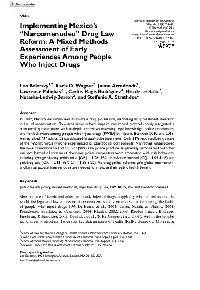
Abstract In 2009, Mexico decriminalized small-scale drug possession, instituting drug treatment diversion in lieu of incarceration. To assess initial reform impact, our mixed methods study integrated a structured questionnaire with in-depth interviews assessing legal knowledge, police encounters, and risk behaviors among people who inject drugs (PWID) in Tijuana. Between 2010 and 2013, we recruited 737 adults; 32 participated in qualitative interviews. Only 11% reported being aware of the...
The spatial–temporal relationship of policing in areas with high drug activity
- Gaines, T. et. al.
- Publicado: 2014

ABSTRACT In 2009, Mexico decriminalized the possession of small amounts of illicit drugs for personal use in order to refocus law enforcement resources on drug dealers and traffickers. This study examines the spatial distribution of law enforcement encounters reported by people who inject drugs (PWID) in Tijuana, Mexico to identify concentrated areas of policing activity after implementation of the new drug policy. Mapping the physical location of law enforcement encounters...
Marcando al delincuente: estigmatización, castigo y cumplimiento del derecho
- Catalina Pérez Correa
- Publicado: 2013
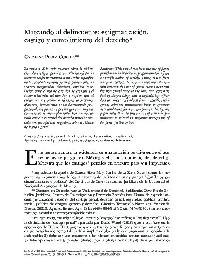
Resumen Este texto muestra cómo la aplicación de castigos penales en México afecta de manera desproporcionada a un sector específico de la sociedad: hombres jóvenes provenientes de sectores marginados. Asimismo, analiza la relación entre el uso de este tipo de castigos y el incumplimiento del derecho, y sugiere que al estigmatizar y excluir a ofensores (o presuntos ofensores) provenientes de un determinado grupo social, las penas de prisión...
Uso de la fuerza letal. Muertos, heridos y detenidos en enfrentamientos de las fuerzas federales con presuntos miembros de la delincuencia organizada
- Catalina Pérez Correa, Carlos Silva y Rodrigo Gutiérrez
- Publicado: 2012
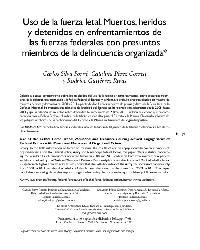
Abstract Debido al escaso conocimiento sobre los resultados del uso de la fuerza en enfrentamientos entre presuntos miembros de la delincuencia organizada y la Policía Federal, el Ejército y la Marina, el artículo presenta el saldo en materia de muertos, heridos y detenidos de 2008 a 2011, a partir de dos fuentes: reportes de prensa y datos de la Secretaría de la Defensa Nacional. Se muestra que el índice de letalidad del Ejército se ha elevado...
